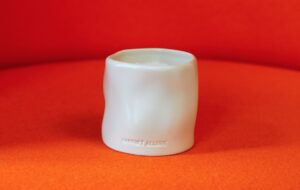


words Kieran Long
In 1996, an advertising campaign by the Berlin city authorities wrote the slogan “Berlin wird” all over the city – “Berlin becomes”.
At this time, Berlin was the largest building site in Europe, reconstructing itself at an extraordinary pace. An architect from the city recently described for me the decade after the demolition of the Berlin wall in 1989: “They were accelerating through these projects so quickly that by the time they were built they were starting to have a debate about whether they had the right approach.”
Photographer Frank Thiel was born and raised in east Berlin, but after a period of imprisonment by the east German authorities for subversive political activities he was expelled to the west as a political dissident in 1985. He took up photography two years later, and in 1995, just a year before the “Berlin wird” advertisements, he began the project of documenting the lightning-fast development of his reunified home city. A selection of these photographs is collected in Frank Thiel: A Berlin Decade 1995-2005, a handsome book published by Hatje Cantz.
The most famous of Thiel’s works is undoubtedly his competition-winning project for Checkpoint Charlie in Berlin. At the site of the old checkpoint, Thiel erected a double-sided lightbox. If you approach it from the former east, you see a large portrait of an American soldier. If you approach it from the former west, a Russian soldier looms large. This monument is a curious one, and more controversial than it first seems. To show portraits of American and Russian (rather than east German) soldiers suggests that the division of the city was monitored by greater powers than the city, or even Germany, itself. This is a German artist looking outwards in a country that built its culture on a pathological desire to admit self-guilt.
German photography has been dominated for decades by a certain objective aspiration that derives from Bernd and Hilla Becher’s documentary photography. Students of Bernd Becher’s in 1970s Düsseldorf included Thomas Struth, Andreas Gursky, Thomas Ruff and Candida Höfer. Thiel’s work has been compared to this documentary style but seems to have a political dimension, and certainly is more temporal – this is a deliberately time-specific collection. Thiel’s Berlin is a forest of cranes with brambles of scaffolding, a city pitted with the concrete foundations that keep Berlin’s architecture from sinking into the soft Brandenburg sand.
Thiel’s is also a city of ongoing demolition, of paint peeling and jackhammers eating into built fabric. In Stadt 5/23/C (Berlin) a geometric concrete facade has had a section removed, revealing a view of a cathedral dome behind. One of the most beautiful series is Thiel’s photographs of small facade tests constructed to demonstrate how new buildings will look once complete. The best is Stadt 9/07 (Berlin), a grey section of facade on stilts that looks like a sinister scoreboard, or something used in a Spielberg movie to communicate with a spaceship. Behind it rises the golden facade of the Axel Springer Verlag building, one of the emblems of west German capitalism.
It seems significant that this book would be published now, when the city is skint and wracked with unemployment, and the cranes have disappeared. The idea of Berlin as a city constantly in the making has been around since much before 1989. In 1910 the critic Karl Scheffler coined the axiomatic phrase: “Berlin is condemned forever to become and never to be.” In the 1920s Berlin was becoming the louche art capital of the world, before that was unceremoniously halted by the Nazis. In the 1990s Berlin was becoming the east/west capitalist metropolis everyone assumed it should be. But that process has been halted by Berlin’s appropriation as a branded bohemia. In the words of its own mayor, Klaus Wowereit: “Berlin is poor, but sexy.”
Last year I had a rather depressing conversation with a young London architect who told me he was moving to Berlin. I asked him why. “Well, it’s the new Hackney, isn’t it?” he said. Thiel’s Berlin is finished, at least for now. And what has it become? A place of biennales and bankrupts, and trust fund kids enjoying the atmosphere.
Frank Thiel: A Berlin Decade 1995-2005 is published by Hatje Cantz, €49.80
www.hatjecantz.de

















